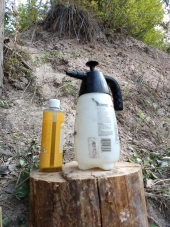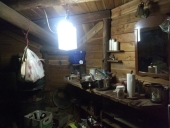
 30
30




 7
7




Joy to You
 8
8




 14
14




David N Black wrote:The taste of wild-foraged leaves may range from nothing to bad to quite good. They may not always be candidates for a meal in themselves, but mixed in with other flavorful ingredients they can still provide all the nutritional benefits of eating leafy greens. Douglas fir grows abundantly around here, and the new needles have a pretty strong flavor on their own. Chopping the needles finely and mixing them with coffee grounds before brewing though makes a drink that I am really starting to like that also provides vitamin C and is hardly any additional work. If you come across some leaf (that you are certain is edible) with a taste that's not great, consider first if the flavor is just unfamiliar and then think about ways it could be combined with other flavors to make something good. Most edible herbs are pretty objectionable when eaten on their own and raw.
De-fund the Mosquito Police!
Become extra-civilized...
 10
10




 8
8




 7
7




 12
12




 8
8




 7
7




 9
9





 9
9




Hans Albert Quistorff, LMT projects on permies Hans Massage Qberry Farm magnet therapy gmail hquistorff
 3
3




 9
9




 8
8




 4
4




Benjamin Abby wrote:Sassafras leaves have been ate forever and the root was once used but has a carcinogen (doesn't stop people from eating red meat though). God forbid if you mention this idea to the wrong person. I don't personally use the root but I think we like to simplify nature where this one thing is a carcinogen but perhaps another thing in the sassafras protects you from it such as antioxidants vs free radicals. I don't know but I know it has been used for a very long time and maybe the good in it counters the bad or there are so many positives the negatives are worth it (aka drugs/medicines since they all have side effects but if they are more beneficial than negative then that is called a good thing).
De-fund the Mosquito Police!
Become extra-civilized...
 3
3




 2
2








Isaiah Bohin wrote:Benjamin, actually if you look into the studies finding safrole oil to be toxic, what they essentially did was make a concentration hundreds of times stronger than what you could consume naturally from food, and then directly injected it into the blood stream of the rat. I think a lot of things would cause liver cancer if introduced in that way. A lot of dietary studies are similarly simplistic like this and I think are more done to pad an academic career (publish or perish and all that) or as part of a corporate agenda.
Similarly, most studies saying red meat is bad for you are 1) basically just surveys where they contact people with certain types of cancer and ask them to remember how much of X food they’ve had a week for the last several decades potentially, nothing actually showing a causation. and 2) basically just a study on the Standard American Diet being bad for you. Which isn’t anything revolutionary as far as ideas go, of course fast food burgers (and cake, and milkshakes, and chips, etc etc) aren’t good for you. But there’s never been a study actually looking into a causation or even correlation between cancer and say, grassfed organic meat consumption with a diet high in vegetable and fruit fiber.
Here are some studies somewhat along those lines that you may find interesting, however.
https://www.nature.com/articles/1601353
https://academic.oup.com/ajcn/article/71/3/682/4729121
Unsurprisingly, it’s more about food quality than quantity, and the diet we’ve had for hundreds of thousands of years is indeed one that we’ve evolved to be good for us.
https://en.m.wikipedia.org/wiki/Pleistocene_human_diet




Benjamin Abby wrote:The sugarberry leaves weren't sweet but are neutral to me and I've started eating the leaves with each meal. I wanted a short post but it doesn't seem like I can do that lol.
I wasn't going to try the roots because I had only found 2 small trees in my yard and I feared killing them but after exploring my little forest I have found many more. I'm new to this stuff so I have the fear that taking up any root would kill a tree lol. I know it isn't true but still.
Isaiah and Coydon, great points! Does anyone know if this is the reason for all the fear pushing over things like oxalic acid and other antinutrients? Similar to cyanide in apple seeds; an expert said you'd have to eat the seeds of about 200 apples consecutively to have an issue lol. I planted blue flax this year which says to cook because the seeds have cyanide. But they don't say how much cyanide and I believe in "dose is the poison or the cure." It is like when places say don't eat large amounts but don't define it in any way. Is "large amounts" more than any sane human would eat or something normal like a cup or even two? Comfrey and so many others that have been used safely for thousands of years. I think Comfrey had 4 or 5 bad cases they point to and these were extreme which is just like the fear over kale where the woman ate more kale than anybody would ever normally. And it usually wasn't just the plant but supplements and comfrey oral supplements are banned due to this. Comfrey is apparently one of the few plants that take up Vit B12 also.
 4
4




Roy Edward Long wrote:Specifically regarding oxalic acid, the biggest problem with it is that it interferes with the digestion of iron and calcium. For most Americans and their horrible nutrient deficient diets that could be a problem. For those of foraging and eating healthy diets we actually have the concern of too much iron and calcium intake which becomes dangerous. My cousin Jon is unable to get rid of iron and he has to give blood several times a month to keep his iron levels where they belong. Too much iron is slowly causing him to become schizophrenic due to iron buildup in his brain. Too much calcium leads to more calcium in the kidneys which then reacts with cystine kinase, potassium etc which then crystalizes into stones inside the kidneys. Oxalic acid helps to protect us from these issues. In a very natural diet oxalic acid is a life saver. Why do you think so many of our leafy veggies bred by our ancestors are high in oxalic acid?
De-fund the Mosquito Police!
Become extra-civilized...

|
Anderson gave himself the promotion. So I gave myself this tiny ad:
Learn Permaculture through a little hard work
https://wheaton-labs.com/bootcamp
|




